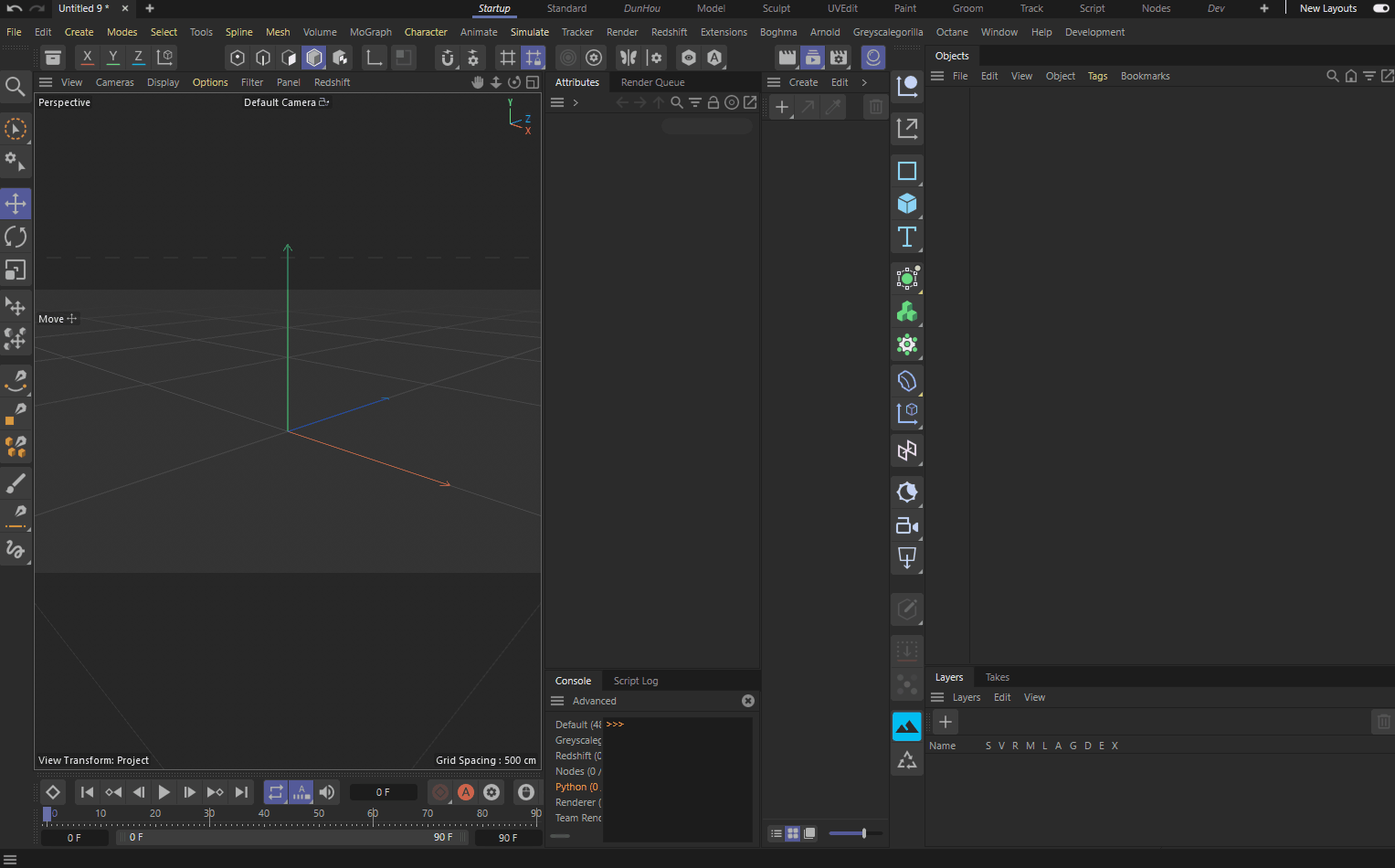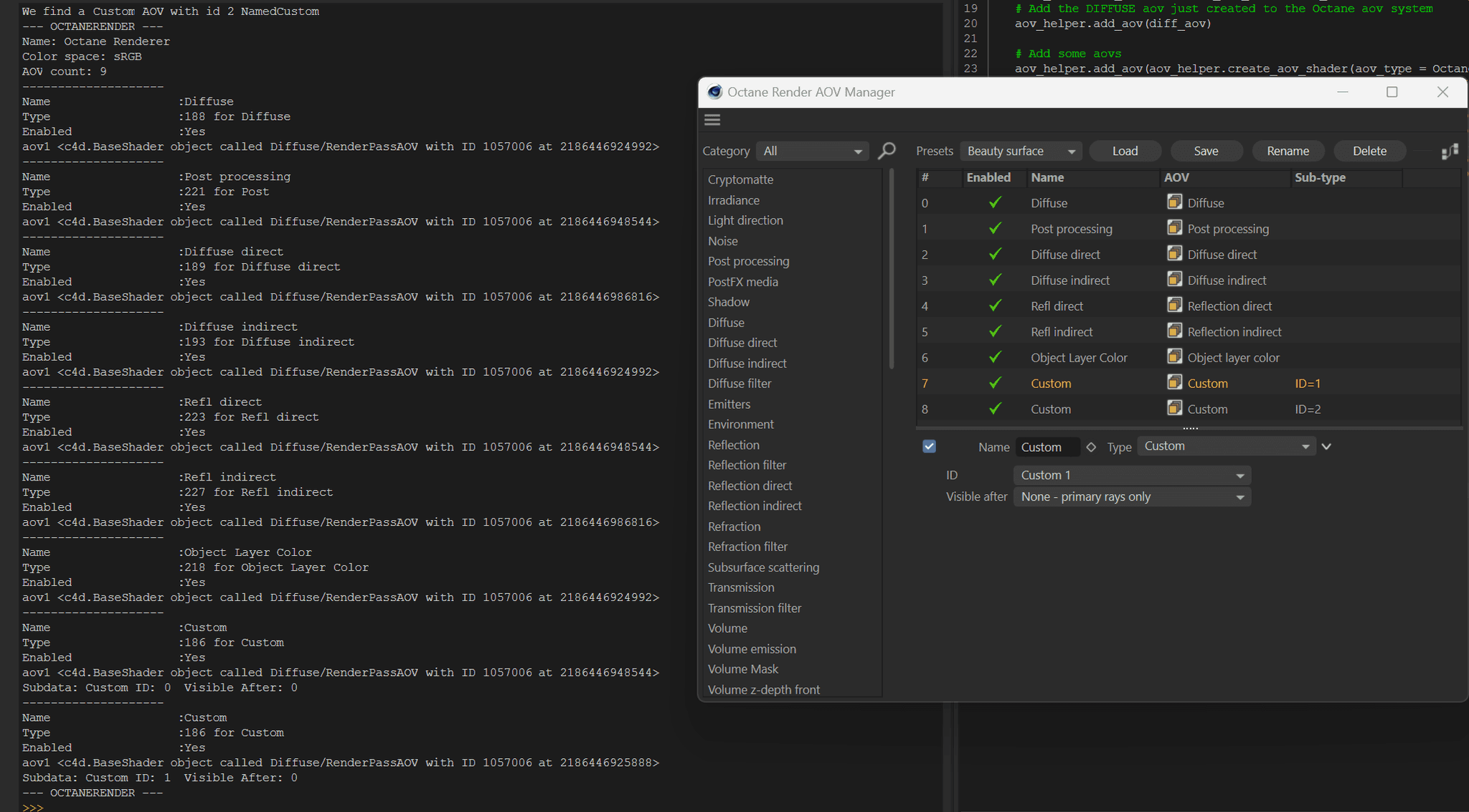Open source wrapper for Octane/Redshift/Arnold/Vray/Corona in Cinema 4D.
-
Hi community!
Older version called renderEngine had been move to versions folder, if you are still interested.Renderer is a wrapper class for the
maxonandc4dapi of popular render engine for Cinema 4D.Intended for more user-friendly manipulation of node materials with the new maxon.GraphNode model. And also with Octane Material.
Provide helper class for convenient access AOV , Material , Scene Object(Object/Tag/Light/...) in Cinema 4D popular renderer.
I try to keep it as same as possible, but each renderer has their own logic, so there are some compromises.
Happy Rendering and Scpriting!

Cheers~
DunHou
Renderer
This is a custom wrapper for most popular render engine like Octane\Redshift\Arnold\Corona\VRay in Cinema 4D, which is also contains in boghma library.
All the boghma plugins and boghma library is FREE.Supported Renderer
- Octane
- Corona
- Node Materials with the new GraphNode model
- Redshift ( Only Node Material for Material Helper)
- Arnold ( Only Node Material for Material Helper)
- Vray ( Only Node Material for Material Helper)
Installation
- (Recommend) Download Boghma Plugin Manager and install any plugin, the boghma lib will auto installed or updated.
- Download the source code and import it to your Cinema 4D.
Quick Intro
import c4d import maxon from Renderer import Redshift, EasyTransaction, TextureHelper from pprint import pprint # Create a TextureHelper instance # 创建一个 TextureHelper 实例 tex_helper: TextureHelper = TextureHelper() # Get the url with given asset id # 获取给定资产ID的URL # "si-v1_fingerprints_02_15cm.png" with AssetId : file_fa9c42774dd05049 disp: maxon.Url = tex_helper.GetAssetUrl("file_fa9c42774dd05049") def HowToUse(): """ How to reate a redshift material and modify the gragh with EasyTransaction. """ # Create Redshift Node Material instance, if no material filled, we create a new STD material # 创建一个Redshift节点材质实例,如果没有材质传入,创建新的STD材质 material: c4d.BaseMaterial = Redshift.Material("MyMaterial") # Use EasyTransaction to modify the graph # 使用EasyTransaction来修改材质 with EasyTransaction(material) as tr: # the attribute #tr is the instance of Redshift.MaterialHelper, # we got it with just apply to the #material to the EasyTransaction # it will inherit from NodeGraghHelper class # 属性tr是Redshift.MaterialHelper的实例,通过将材质赋予EasyTransaction获得,继承自NodeGraghHelper # Use Redshift.MaterialHelper methods : add a texture + displacement to the Output node # 使用Redshift.MaterialHelper中的方法: 添加图片+置换节点到Output节点 tr.AddDisplacementTree(filepath = disp, shadername = "DISP") # Use NodeGraghHelper methods: get the Output(endNode) # 使用NodeGraghHelper中的方法: 获取输出节点 output = tr.GetOutput() print(f"{output = }") # Insert the material to the document # 导入材质(来自Redshift MaterialHelper) tr.InsertMaterial() # Auto apply GraphTransaction.Commit() to the graph # 退出with后, 自动执行GraphTransaction.Commit()Limit
- For some reasons, AddShader-like methods(maxon.GraphModelInterface.AddChild) will add the node in the center of the graph, if we call those methods on exsited material, it will return a mess graph, you can call Renderer.ArrangeAll() after.
- Material(except Octane) helper only support material with the new GraphNode model(Node Material after R26)
- Due to Octane use his Custom UserArea UI base on old layer system, and didn't support python, we can only modify Octane materials in material level, but can not interactive with selections in octane node editor.
- Also Octane materials didn't have a "port" or "wire" context, we can not use all those methods as same as NodeGraghHelper.
- Arnold mask tag SetPrameter has a refresh bug.
Examples
Class Presentation and Highlights
Renderer
- NodeGraghHelper
- TextureHelper
- EasyTransaction
- Redshift
- AOV
- Material
- Scene
- Octane
- AOV
- Material
- Scene
- Arnold
- AOV
- Material
- Scene
- Vray
- AOV
- Material
- Corona
- AOV
- Material
- utils
- NodeGraghHelper
- TextureHelper
- EasyTransaction
- constants
Version & Updates
-
 F ferdinand pinned this topic on
F ferdinand pinned this topic on
-
Hey @Dunhou,
This looks AWESOME! Thank you so much for all the awesome stuff you create!
I have pinned this topic, so that it remains visible.
Cheers,
Ferdinand -
this looks amazing. Can't wait to see arnold / RS
-
Hey @ferdinand , that's very honor to contribute to the community, and also thanks for your pin, that inspire me a lot too.
And a little plan I want to take your advice, what do you think the next update I should post, should I edit the first post, or just update the links when redshift/arnold is ready, and reply to the topic to show the main changes? which is better for more read convinence?
Cheers~
DunHou -
Hey @thomas , thanks for your like, redshift_helper is 80% for beta I think, I will try to post ASAP.
Cheers~
DunHou -
Hi community!
the renderEngine helper is beta now, I set version number to 1.0.0, it contains three renderer now:
- Octane
- Arnold ( MaterialHelper only support NodeGragh )
- Redshift ( MaterialHelper only support NodeGragh )
I personally not use Vray and Corona quite often, if anyone is a pro user of these , very welcome to add them to renderEngine
You can modify the aovs/materials with renderEngine quickly and easliy . See the examples above this topic.
Hope you can have fun with it, and any improvement and fix is very appreciated.
Cheers~
DunHou -
@Dunhou is it possible to get in touch for you for freelance development? I couldn't find any email or socials.
-
@thomas Hi, I had update my github readme file, and put my email on it

Cheers~
DunHou -
 D Dunhou referenced this topic on
D Dunhou referenced this topic on
-
Hi community!
Th renderEngine library has been updated to the 1.0.4 version, there are some re-write functions and may not incompatible with older versions,see the main changes as follows:
- rename all node & material functions to Capitalize style.
- remove transaction in node_helper, use it in the final scripts.
- organize the functions in node_helper with comments ( node\port\wire\util )
- add some functions to check node or port info, like if it is connected , see the README.
- add a InserShader function to create a shader into a wire.
- re-write RemoveConnection in node_helper and support one argument(port) to remove connection.
- see the Version & Updates
Cheers~
DunHou -
 D Dunhou referenced this topic on
D Dunhou referenced this topic on
-
 D Dunhou referenced this topic on
D Dunhou referenced this topic on
-
Hi community!
Since my last post, I had some updates and fix to this library.
And the following picture shows the new node functions added to my Render Flow plugin based on the use of this library within few lines( just the node context ).
Have fun with it.
Cheers~
DunHou
-
@Dunhou
It's realy cool and usefull, keep going bro
-
Wow ... good stuff
My c4d Programing slowed down this year, but this might be something I want to use some day ... -
amazing!
-
 D Dunhou referenced this topic on
D Dunhou referenced this topic on
-
Hi community!
New versions here!
I had change the name from renderEngine to Renderer, and also changed the main structure. see more in the very first of this topic. (renderEngine had been move to versions folder, if you still interested.)
This version is way more organized and user-friendly, you can use few lines of code to do something normal work, find an example below:
Cheers~
DunHou
Result:

Code:
import c4d import maxon from Renderer import Redshift, EasyTransaction, TextureHelper tex_helper: TextureHelper = TextureHelper() disp: maxon.Url = tex_helper.GetAssetUrl("file_fa9c42774dd05049") def HowToUse(): material: c4d.BaseMaterial = Redshift.Material("MyMaterial") with EasyTransaction(material) as tr: tr.AddDisplacementTree(filepath = disp, shadername = "DISP") tr.InsertMaterial() if __name__ == '__main__': HowToUse() -
Hi community!
Here is a little example of how we modify aovs in Octane, find more examples in the top.
Have fun with it

Cheers~
DunHouResult:

Codes:
import c4d import maxon import Renderer from Renderer import Octane from pprint import pprint # How to create and modify octane aovs def modify_octane_aov(): # Get the doc host the aovs, in this case th active doc doc: c4d.documents.BaseDocument = c4d.documents.GetActiveDocument() # Set Octane AOVHelper instance aov_helper = Octane.AOV(doc) # Create a Octane aov item # the id can find from Renderer.constants.octane_id.py or in octane folder # If #name is None, defulat to type. diff_aov = aov_helper.create_aov_shader(aov_type = Octane.RNDAOV_DIFFUSE) # Add the DIFFUSE aov we just created to the Octane aov system aov_helper.add_aov(diff_aov) # Add some aovs aov_helper.add_aov(aov_helper.create_aov_shader(aov_type = Octane.RNDAOV_POST,aov_name = 'POST')) aov_helper.add_aov(aov_helper.create_aov_shader(Octane.RNDAOV_DIF_D)) aov_helper.add_aov(aov_helper.create_aov_shader(Octane.RNDAOV_DIF_I)) aov_helper.add_aov(aov_helper.create_aov_shader(Octane.RNDAOV_REFL_D)) aov_helper.add_aov(aov_helper.create_aov_shader(Octane.RNDAOV_REFL_I)) aov_helper.add_aov(aov_helper.create_aov_shader(Octane.RNDAOV_WIRE)) aov_helper.add_aov(aov_helper.create_aov_shader(Octane.RNDAOV_OBJECT_LAYER_COLOR)) aov_helper.add_aov(aov_helper.create_aov_shader(Octane.RNDAOV_VOLUME)) # Remove last aov: volume aov_helper.remove_last_aov() # Remove specified aov: wire aov_helper.remove_aov_type(aov_type = Octane.RNDAOV_WIRE) # Add 2 custom aovs with id 1 and 2 aov_helper.add_custom_aov(customID = 1) aov_helper.add_custom_aov(customID = 2) # Get the custom aov with id 2 custom2 = aov_helper.get_custom_aov(customID = 2) if custom2: print(f'We find a Custom AOV with id 2 Named{custom2.GetName()}') # Print current aov info aov_helper.print_aov() if __name__ == '__main__': Renderer.ClearConsole() modify_octane_aov() -
Hi community!
Here is a little example of how we modify scene objects in Arnold, find more examples in the top.
We want:
- Add a Arnold Sky with hdr
- Add a gobo light with a node-base gobo material, and a IES light
- Add a cube and add a custom mask to the driver
- Add a Scatter with custom instance shapes
- Auto export proxy with a BaseObject and load back the ass file (need to save project first)
Have fun with it

Cheers~
DunHouResults:


Codes:
import c4d import maxon import Renderer from Renderer import Arnold, TextureHelper from pprint import pprint # Create a TextureHelper instance tex_helper: TextureHelper = TextureHelper() # How to create and modify arnold scene def modify_arnold_scene(): # Get the doc host the scene, in this case th active doc doc: c4d.documents.BaseDocument = c4d.documents.GetActiveDocument() # Set arnold SceneHelper instance scene_helper = Arnold.Scene(doc) ### == Light == ### # Add a rig of hdr and rgb backdrop hdr_url: str = tex_helper.GetAssetStr(maxon.Id("file_d21cf4cfdec8c636")) scene_helper.add_dome_rig(texture_path = hdr_url, rgb = c4d.Vector(0,0,0)) # Add a light object and and some modify tags gobo_url: maxon.Url = tex_helper.GetAssetUrl("file_66b116a34a150e7e") gobo_light = scene_helper.add_gobo(texture_path = str(gobo_url), intensity=2, exposure=0) scene_helper.add_light_modifier(light = gobo_light, gsg_link = True, rand_color = True) # Add a IES light ies_url: str = tex_helper.GetAssetStr("file_6f300f2ba077da4a") ies = scene_helper.add_ies(texture_path = ies_url, intensity=1, exposure=0) ### == Tag == ### # Add a Cude object and an arnold tag with mask_name cube = c4d.BaseObject(c4d.Ocube) scene_helper.add_mask_tag(node=cube, mask_name='My Mask 01') doc.InsertObject(cube) ### == Object == ### # Add a scatter obejct with some children and count 12345 generate_object = c4d.BaseObject(c4d.Oplane) doc.InsertObject(generate_object) scatter_A = c4d.BaseObject(c4d.Oplatonic) scatter_B = c4d.BaseObject(c4d.Ooiltank) doc.InsertObject(scatter_A) doc.InsertObject(scatter_B) scatters: list[c4d.BaseObject] = [scatter_A, scatter_B] scene_helper.add_scatter(generator_node=generate_object, scatter_nodes=scatters, count=12345) # Add a object and set auto proxy the_object = c4d.BaseObject(c4d.Oplane) doc.InsertObject(the_object) the_object.SetName("Original Object") scene_helper.auto_proxy(nodes=the_object,remove_objects=False) if __name__ == '__main__': Renderer.ClearConsole() modify_arnold_scene() c4d.EventAdd() -
Hi community!
Another little update, as we didn't have DataDescriptionDatabaseInterface as @ferdinand said in How can we get the default port of a GraphNode?
I add a ConverterPorts to Renderer, we can use this to get the "default " port of a node until the DataDescriptionDatabaseInterface is valid in python.
Note: It can only provide the str data of the port and it's not 100% rigorousCheers~
DunHou
Result:

Codes:
import c4d from Renderer import Redshift,EasyTransaction,ClearConsole def ConvertTest(): material: c4d.BaseMaterial = c4d.documents.GetActiveDocument().GetActiveMaterial() with EasyTransaction(material) as tr: nodes = tr.GetActiveNodes() for node in nodes: print(f"Node: {tr.GetName(node)}") print(f"Default Input: {tr.GetConvertInput(node)}") print(f"Default Output: {tr.GetConvertOutput(node)}") print("-"*10) if __name__ == '__main__': ClearConsole() ConvertTest() -
Hi community!
I had add a basic support to V-Ray and Corona to fit the basic PBR usage, no Scene and AOV yet (AOV seems I can not get them in python, if someone knows where it stores, please let me know that).
Cheers~
DunHou -
Hi regarding Vray, I once wrote this plugin that have the duty to create ObjectId passes.
I did not try it since age, but previously Vray AOV where stored within a branch on the Render Engine.I don't have vray installed currently, but I guess if you compile the C++ SDK, with the help of the C++ SDK Active Object Example it should be trivial to inspect a Vray scene and find these AOV.
Cheers,
Maxime -
Hi community!
Thanks for @m_adam prompt, I had add a AOV to Vray as same as other renderers, see a basic example here, hope it can help

Cheer~
DunHou
Result:

Code:
import c4d import Renderer from Renderer import Vray def modify_vray_aov(): # Set Vray AOVHelper instance doc = c4d.documents.GetActiveDocument() vp: c4d.documents.BaseVideoPost = Renderer.GetVideoPost(doc, Renderer.ID_VRAY) aov_helper = Vray.AOV(vp) # Add the DIFFUSE aov diff_aov = aov_helper.create_aov_shader(aov_type = Vray.VRAY_AOV_DIFFUSE) aov_helper.add_aov(diff_aov) # Add some aovs aov_helper.add_aov(aov_helper.create_aov_shader(aov_type = Vray.VRAY_AOV_BACKGROUND, aov_name = 'BG')) aov_helper.add_aov(aov_helper.create_aov_shader(Vray.VRAY_AOV_SPECULAR)) aov_helper.add_aov(aov_helper.create_aov_shader(Vray.VRAY_AOV_REFLECTION)) aov_helper.add_aov(aov_helper.create_aov_shader(Vray.VRAY_AOV_SHADOW)) aov_helper.add_aov(aov_helper.create_aov_shader(Vray.VRAY_AOV_LIGHT_MIX)) # Remove last aov aov_helper.remove_last_aov() # Remove specified aov: diffuse aov_helper.remove_aov_type(aov_type = Vray.VRAY_AOV_DIFFUSE[0]) # Print current aov info aov_helper.print_aov() c4d.EventAdd() if __name__ == '__main__': Renderer.ClearConsole() modify_vray_aov()